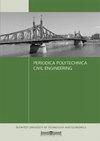基于NiTi sma连接的防爆钢抗弯矩框架可靠性评估方法
IF 1.4
4区 工程技术
Q3 ENGINEERING, CIVIL
引用次数: 1
摘要
本文提出了一种采用镍钛形状记忆合金(NiTi SMA)连接的智能钢抗弯矩框架结构(mrf)在爆炸荷载作用下的可靠性评估方法框架。基于两步法算法,建立了可靠性评估框架。第一步,采用蒙特卡罗拉丁超立方采样策略模拟(MC-LHS)生成不确定参数样本点;考虑到数值模拟,第二步采用简化的性能函数和第一步生成的随机结果。通过直接蒙特卡罗仿真(MCS)和一阶可靠性方法(FORM)验证了该方法的可靠性。性能函数为柱的轴力和弯矩、连接处的转动能力和层间位移比(ISDR)。在可靠性评估的整个发展过程中,概率模型的几何特性、材料特性、垂直载荷、模型误差和载荷重量都是参数化的。将所开发的可靠性框架应用于一个4层智能磁流变框架原型。结构安全等级用可靠度指数(β)表示。结果表明,该可靠性框架能够准确、有效地预测基于NiTi sma连接的mrf结构的破坏。最后,进行敏感性分析,以表明建筑物倒塌对爆炸波特性、材料强度、垂直重力载荷和柱形尺寸的敏感性。灵敏度分析结果也证实了所提出的可靠性框架在观测高敏感参数——装药质量方面的有效性。本文章由计算机程序翻译,如有差异,请以英文原文为准。
Reliability Assessment Methodology of Blast Protective Steel Moment Resisting Frame Using NiTi SMA-based Connection
This paper proposes a methodology framework for the reliability assessment of smart steel Moment Resisting Frame structures (MRFs) equipped with Nickle Titanium Shape Memory Alloy (NiTi SMA) connections subjected to blast loading. The reliability assessment framework is formulated based on a two-step approach algorithm. In the 1st Step, the Monte Carlo Latin Hypercube Sampling Strategy simulation (MC-LHS) is adapted to generate the uncertain parameters sample points. Considering the numerical simulations, the 2nd Step employs simplified performance functions and the generated random outcomes from the 1st Step. The proposed reliability approach is verified against direct Monte Carlo Simulation (MCS) and First-Order Reliability Method (FORM). The performance functions are columns’ axial force and bending moments, rotation capacity at the connections, and Inter-Story Drift Ratio (ISDR). Throughout the development of the reliability assessment, the probabilistic models are parametrized on geometrical properties, material properties, vertical loads, model errors, and charge weights. The developed reliability framework is applied to a prototype 4-story smart MRF. The structural safety level is obtained in terms of the Reliability Index (β). The results show that the reliability framework provides an accurate and efficient structural collapse prediction of the MRFs equipped with NiTi SMA-based connections. Finally, sensitivity analysis is performed to indicate the sensitivity of building collapse to blast wave characteristics, material strength, vertical gravity loads, and column profile dimensions. The sensitivity analysis results also confirm the efficiency of the proposed reliability framework in observing the highly sensitive parameters, which is explosive charge weight.
求助全文
通过发布文献求助,成功后即可免费获取论文全文。
去求助
来源期刊

Periodica Polytechnica-Civil Engineering
工程技术-工程:土木
CiteScore
3.40
自引率
16.70%
发文量
89
审稿时长
12 months
期刊介绍:
Periodica Polytechnica Civil Engineering is a peer reviewed scientific journal published by the Faculty of Civil Engineering of the Budapest University of Technology and Economics. It was founded in 1957. Publication frequency: quarterly.
Periodica Polytechnica Civil Engineering publishes both research and application oriented papers, in the area of civil engineering.
The main scope of the journal is to publish original research articles in the wide field of civil engineering, including geodesy and surveying, construction materials and engineering geology, photogrammetry and geoinformatics, geotechnics, structural engineering, architectural engineering, structural mechanics, highway and railway engineering, hydraulic and water resources engineering, sanitary and environmental engineering, engineering optimisation and history of civil engineering. The journal is abstracted by several international databases, see the main page.
 求助内容:
求助内容: 应助结果提醒方式:
应助结果提醒方式:


